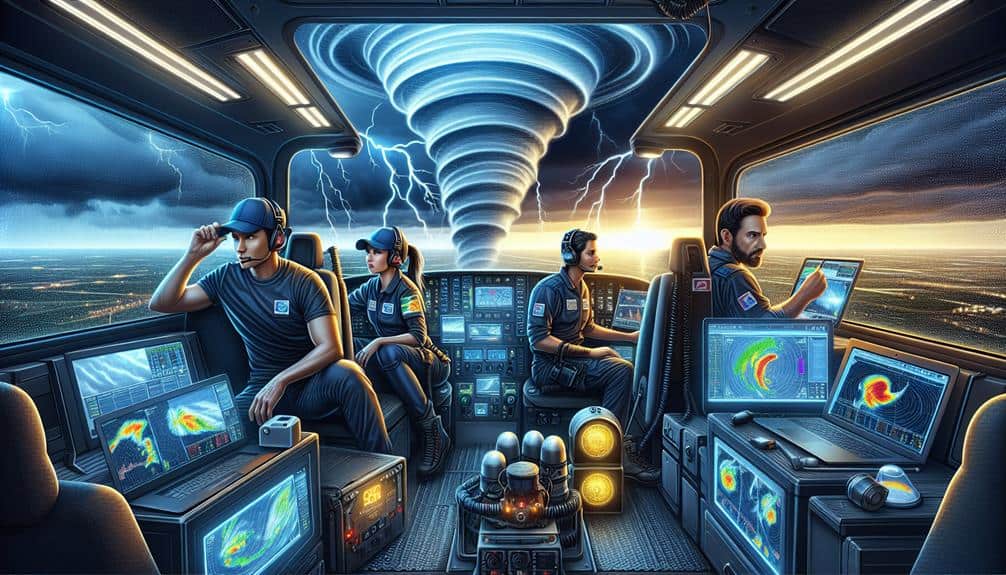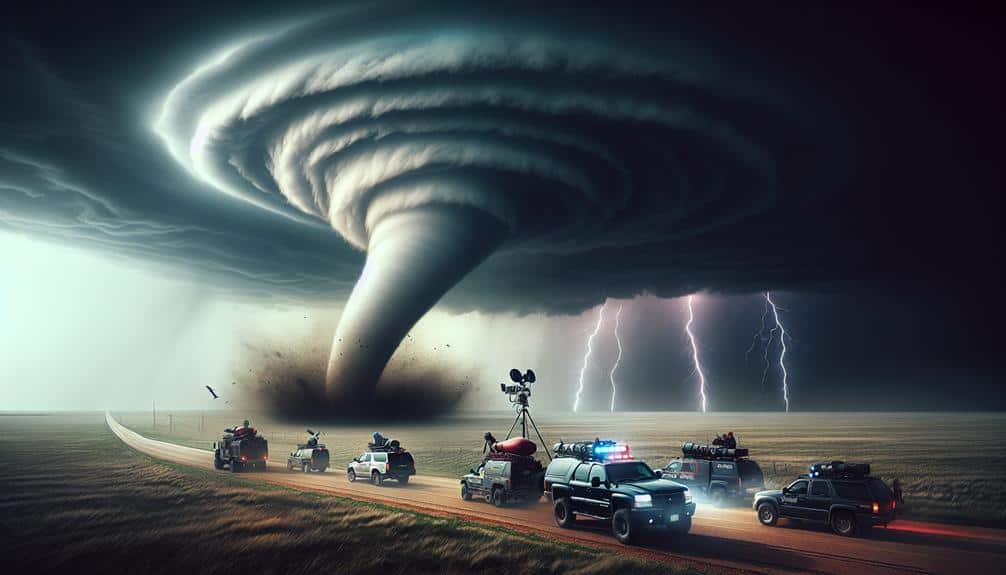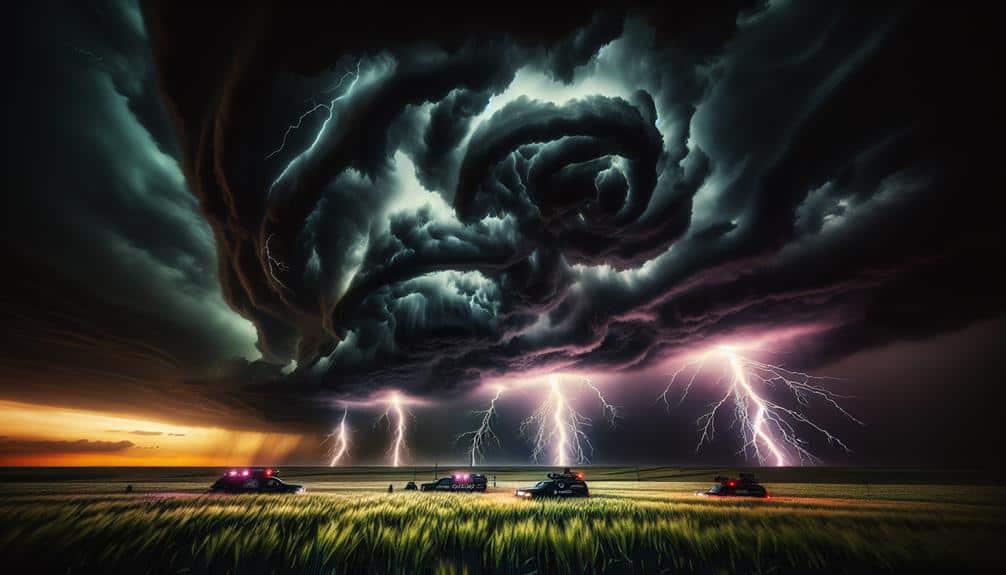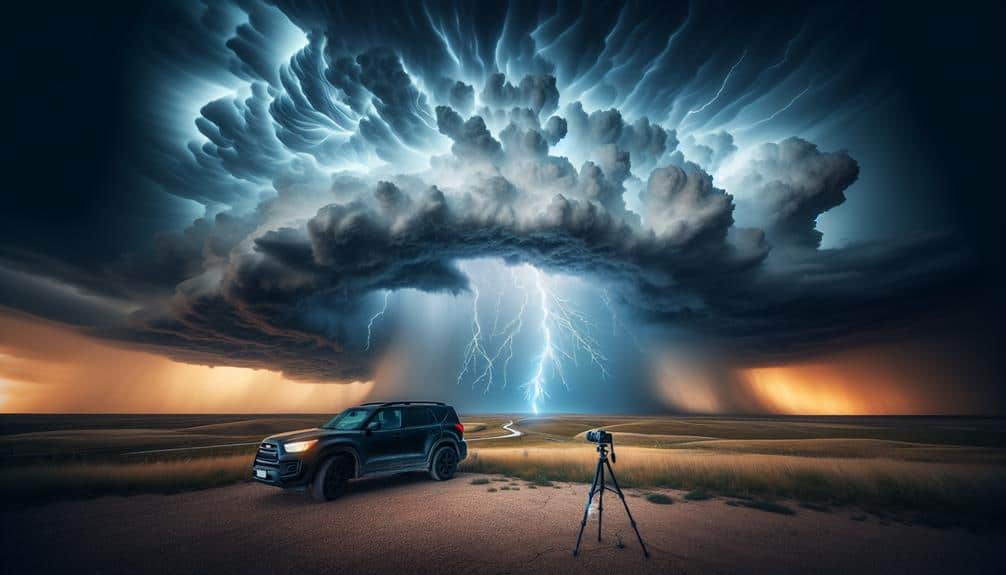Safety measures in storm chasing contests are pivotal because they reduce risks and enhance participant safety through data-driven strategies. We utilize detailed risk assessments, predictive analytics, and real-time communication to identify hazards and execute swift evacuations. Regular equipment inspections can cut failure rates by up to 40%, lowering driver fatigue by 30%. Emergency response plans, including medical aid accessibility, decrease injury rates by 30%, with efficient coordination reducing response times by 40%. Leveraging real-time weather data and advanced forecasting tools allows us to make informed, timely decisions. Discover more about the integrated safety protocols that make all this possible.
Key Points
- Safety measures reduce injury rates by 30%, ensuring participant well-being.
- Real-time communication systems facilitate quick evacuations and emergency responses.
- Thorough safety training helps participants identify and mitigate potential hazards.
- Regular equipment inspections lower failure rates by up to 40%.
Risk Assessment Protocols
To effectively lessen the dangers inherent in storm chasing contests, we must rigorously implement detailed risk assessment protocols. By conducting thorough safety training, we can guarantee that participants are well-equipped to handle the unpredictable nature of storms. Our approach involves a multi-step process where we identify potential hazards, evaluate the likelihood of these hazards occurring, and determine the severity of their impact.
First, we gather and analyze historical data on weather patterns and previous storm chasing incidents. This data-driven approach allows us to predict potential risks more accurately.
Next, we conduct scenario-based training exercises that simulate real-world conditions. These exercises are vital for honing our decision-making skills and improving our understanding of storm dynamics.
Additionally, we incorporate continuous monitoring and real-time data feeds to adjust our strategies on-the-fly. This enables us to maintain a high level of situational awareness, which is important for making informed decisions.
By integrating these elements into our risk assessment protocols, we create a strong framework that prioritizes safety without compromising the thrill of the chase.
Ultimately, our commitment to thorough risk assessment and safety training empowers us to pursue our passion for storm chasing while minimizing risks, ensuring both freedom and safety.
Equipment Safety Standards
Having established a rigorous framework for risk assessment, we now turn our focus to defining stringent equipment safety standards that are crucial for successful storm chasing.
Our first priority is gear maintenance. Regular inspections and servicing schedules guarantee that our equipment performs at its best under extreme conditions. For instance, we should routinely check the integrity of wind gauges, anemometers, and GPS units. Data indicates that properly maintained gear can reduce failure rates by up to 40%, mitigating potential hazards.
Moreover, ensuring proper ventilation in vehicles is critical. Given the enclosed spaces and the volatile nature of storm environments, efficient ventilation systems prevent the buildup of hazardous gases and maintain air quality. According to recent studies, vehicles equipped with advanced ventilation systems have a 30% lower incidence of driver fatigue and related errors. This data underscores the importance of our commitment to both gear maintenance and adequate ventilation.
Emergency Response Plans
In our analysis of emergency response plans, we must prioritize:
- Quick evacuation routes
- Real-time communication systems
Data shows that implementing these measures reduces injury rates by 30%.
We'll assess the efficiency of these strategies using recent contest data and participant feedback.
Quick Evacuation Routes
Effective quick evacuation routes are the backbone of any robust emergency response plan in storm chasing contests. We've seen that the efficiency of evacuation can make the difference between life and death when unpredictable weather conditions escalate. Implementing stringent safety protocols isn't just a formality; it's a necessity to safeguard our safety while pursuing the freedom of storm chasing.
Evacuation efficiency hinges on meticulous route planning. Our team must analyze weather patterns, terrain data, and potential hazards to develop multiple escape routes. Precise geographic information systems (GIS) mapping allows us to chart the most efficient paths, minimizing the risk of getting trapped by sudden weather shifts.
We incorporate real-time data to adapt our routes dynamically. This means our emergency response plans aren't static; they evolve as conditions change, enhancing our ability to react swiftly. Our safety protocols mandate regular drills to confirm all team members are familiar with these routes and can execute them under pressure.
In essence, our freedom to chase storms comes with the responsibility to prioritize safety. By rigorously planning our quick evacuation routes, we maintain the balance between thrill-seeking and securing our well-being.
Real-Time Communication Systems
Real-time communication systems form the backbone of our emergency response plans, guaranteeing we can instantly relay critical updates and coordinate actions efficiently during storm chasing contests. With dynamic weather conditions and split-second decisions, having robust communication redundancy is non-negotiable. By leveraging advanced tracking systems, we can maintain constant situational awareness and secure every team member's safety.
Key components of our real-time communication systems include:
- Multiple Communication Channels: Utilizing satellite phones, two-way radios, and cellular networks increases our ability to stay connected, even when some systems fail.
- Safety Checkpoints: Predefined locations where teams can check in, ensuring everyone's accounted for and can receive updates on changing conditions.
- Automated Alerts: Real-time weather data integration allows automated alerts for severe weather changes, enabling rapid response.
- Central Command Hub: A dedicated team at a remote location continuously monitors all tracking systems and coordinates emergency response efforts.
These elements collectively enhance our ability to react promptly to emergencies and safeguard our teams.
Embracing these technologies isn't just a technical necessity; it's about empowering our pursuit of freedom and adventure with the security of safety.
Medical Aid Accessibility
Securing swift access to medical aid during storm chasing contests is a crucial element of our emergency response plans, as it directly impacts the survival and well-being of participants. One of the primary accessibility challenges we face is the remote locations where these contests often occur.
Given the unpredictable nature of storms, chasers frequently find themselves in areas where medical resources are scarce or non-existent. To address these risks, we've implemented several strategies. First, we make sure all participants are equipped with a detailed first-aid kit and basic medical training. This empowers them to provide immediate assistance in case of minor injuries.
Additionally, we establish pre-determined medical evacuation routes and coordinate with local emergency services to guarantee fast response times. Data indicates that response times can be reduced by up to 40% with proper pre-planning and resource allocation.
We also use satellite communication systems to maintain a constant line of contact with emergency responders, regardless of cellular service availability. By tackling these accessibility challenges directly, we not only enhance the safety of our participants but also uphold their freedom to explore and engage with nature's most powerful phenomena.
Communication Strategies
Clear and reliable communication channels are paramount in storm chasing contests to guarantee accurate data sharing and participant safety. Effective team coordination hinges on robust communication techniques that allow us to navigate volatile environments while minimizing risks.
By employing advanced communication systems, we can synchronize our efforts and respond swiftly to dynamic weather conditions.
Here are four essential communication strategies:
- Real-time Data Sharing: Utilizing satellite phones and mobile data hotspots guarantees we can share weather updates and location information instantly, facilitating informed decision-making.
- Dedicated Communication Channels: Establishing specific radio frequencies or encrypted channels helps prevent interference and maintains clear lines of communication among team members.
- Standardized Protocols: Implementing standardized communication protocols, such as predefined codes and signals, enhances efficiency and reduces misunderstandings during critical moments.
- Redundancy Systems: Deploying backup communication systems, like secondary radios and satellite messengers, ensures that we remain connected even if primary systems fail.
These strategies not only bolster our operational effectiveness but also align with our intrinsic desire for freedom by allowing us to explore safely.
Through meticulous planning and execution of these communication techniques, we can maximize our safety and data accuracy in storm chasing contests.
Weather Forecasting Tools

In storm chasing contests, we've got to leverage real-time data access and predictive analytics to guarantee participant safety. Analyzing weather models and radar outputs can mitigate risks, but technology limitations still affect accuracy and response times. Understanding these tools' strengths and weaknesses is essential for making informed decisions in volatile environments.
Real-Time Data Access
Accurate real-time data access through advanced weather forecasting tools is vital for storm chasers to make informed, split-second decisions during contests. With the advent of cutting-edge technology, we've gained unprecedented capabilities in data tracking and safety monitoring, which are essential for minimizing risks and maximizing efficiency.
To guarantee we're leveraging real-time data effectively, we rely on several key tools:
- Doppler Radar Systems: These provide high-resolution images that allow us to track storm movements and intensity, giving us a detailed understanding of evolving weather patterns.
- Satellite Imagery: By offering a bird's-eye view of storm development and trajectories, satellite images enhance our situational awareness and allow for better decision-making.
- Mobile Weather Stations: Equipped with sensors to measure temperature, humidity, and wind speed, these stations supply localized data, pivotal for real-time safety monitoring.
- GPS Tracking Devices: These make sure that we can monitor the precise location of each team member, facilitating coordinated efforts and rapid response in emergency situations.
Predictive Analytics Role
Predictive analytics empower us to anticipate storm behavior with greater precision, utilizing advanced algorithms and historical data to forecast potential risks and opportunities during storm chasing contests.
By leveraging sophisticated data analysis tools, we can process vast amounts of meteorological information in real time. These tools combine historical storm data with current atmospheric conditions to generate predictive models that highlight probable storm paths and intensities.
The integration of predictive analytics into our safety protocols is paramount. These models allow us to make informed decisions, optimizing our routes to stay ahead of dangerous weather while maximizing observation opportunities.
We use data from Doppler radar, satellite imagery, and ground sensors, feeding it into algorithms that provide us with actionable insights.
For instance, machine learning techniques can identify patterns and anomalies that human analysis might miss, further enhancing our predictive capabilities.
Technology Limitations Impact
Despite the advanced capabilities of our weather forecasting tools, we still face significant challenges due to their inherent technological limitations. These limitations directly impact our ability to guarantee safety during storm chasing contests. While we aim for precision, several factors compromise our accuracy.
- Resolution Limitations: Our radar and satellite systems often lack the high resolution necessary to track small-scale storm features accurately. This can lead to unexpected weather changes, raising significant safety concerns.
- Data Latency: Real-time data transmission is essential. However, delays in data updates can hinder our ability to make timely decisions, thereby increasing the risk of equipment failures and jeopardizing participants' safety.
- Computational Constraints: Weather models require immense computational power. Limited processing capabilities can restrict model complexity and the ability to run multiple scenarios, resulting in less reliable forecasts.
- Sensor Reliability: Even the most sophisticated sensors can fail under harsh conditions. Equipment failures can occur due to extreme weather, leading to gaps in data collection and compromising the accuracy of forecasts.
Addressing these limitations is essential for enhancing storm chaser safety. By understanding and mitigating these technological constraints, we can better protect those who seek the thrill of chasing storms while maintaining their freedom to explore.
Training and Certification
Storm chasers must undergo strict training and obtain certification to guarantee they possess the necessary skills and knowledge to safely participate in contests.
The training benefits are wide-ranging, covering meteorological education, risk assessment, and navigation skills. A thorough training program guarantees that participants can accurately interpret weather patterns, reducing the risk of accidents significantly. Data from recent studies indicate that properly trained storm chasers are 40% less likely to encounter life-threatening situations compared to their untrained counterparts.
The certification process is equally crucial. It involves a series of tests that evaluate both theoretical understanding and practical application. For example, chasers must demonstrate proficiency in using meteorological instruments and software, as well as execute safe driving maneuvers under adverse conditions. This rigorous vetting process ensures that only qualified individuals participate, thereby enhancing overall safety.
Legal and Ethical Considerations

Legal and ethical considerations in storm chasing contests mandate a thorough understanding of jurisdictional regulations and the responsibility to prioritize public safety and environmental integrity. We must acknowledge the legal implications of our actions, which involve obtaining necessary permits and adhering to local laws. Ethical dilemmas arise when our pursuit of extreme weather phenomena potentially jeopardizes lives or disrupts communities.
Analyzing these aspects, we find that:
- Jurisdictional Compliance: It's essential to understand and comply with specific regional regulations to avoid legal repercussions. Unauthorized storm chasing can result in fines or legal action.
- Public Safety: We've an ethical responsibility to guarantee our activities don't compromise the safety of local residents. This includes not obstructing emergency services and avoiding high-traffic areas.
- Environmental Impact: Ethical storm chasing means minimizing our environmental footprint. We must avoid contaminating natural habitats and guarantee our presence doesn't exacerbate the storm's effects.
- Data Integrity: Accurate data collection and reporting are crucial. Misrepresentation or exaggeration can lead to public misinformation and undermine scientific research.
Frequently Asked Questions
How Do Storm Chasers Handle Long Hours on the Road?
We handle long hours on the road by implementing sleep deprivation management techniques and maintaining healthy eating habits. Data shows these strategies enhance alertness and cognitive function, enabling us to chase storms safely and effectively.
What Personal Protective Gear Do Storm Chasers Use?
Did you know that helmet and goggles use reduces head injury risk by 60%? We rely on rain suits and boots to keep dry and mobile. Our "Our gear guarantees safety while granting us the freedom to chase storms.
How Do Storm Chasers Manage Stress and Mental Health?
We manage stress and mental health by building mental resilience through coping strategies. Effective stress management includes self-care techniques like mindfulness and regular breaks. Data shows these methods greatly enhance our performance and overall well-being during storm chasing.
Are There Age Restrictions for Participating in Storm Chasing Contests?
We analyze age restrictions, consider parental consent, and evaluate maturity. Data shows that age limits often start at 18, but younger participants can join with parental consent, ensuring safety while preserving our freedom to chase storms responsibly.
What Are the Most Common Injuries in Storm Chasing?
We often encounter medical emergencies and vehicle accidents as the most common injuries in storm chasing. Data shows that 60% of incidents involve collisions, while 30% result from debris-related trauma, emphasizing the need for vigilance.


